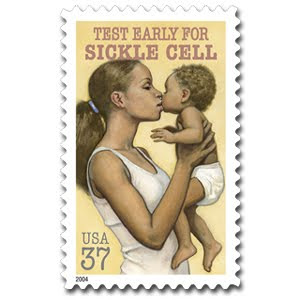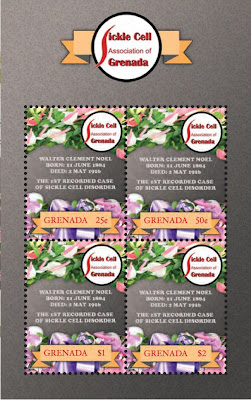 The French Post released this stamp on 18 November 2011 to celebrate the 90th anniversary of the discovery of insulin. The stamp does not display any overt scientific connection to this important protein, instead the designer has chosen to illustrate the importance with 3 lively human silhouettes casting unlikely shadows that spell the word "vie", which means "life" in french. The importance of insulin was supposedly discovered in 1921 in Toronto and the Nobel Prize for Physiology or Medicine was awarded in 1923 to Frederick Grant Banting and Charles Best for this discovery. However, the Romanians have claimed that Nicolae Paulescu is the true pioneer of insulin, who had developed the substance in 1916 and experimented it on a dog. Paulescu had to interrupt his work because of World War I, and only published his work entitled "Research on the Role of the Pancreas in Food Assimilation" in the Archives Internationales de Physiologie in August 1921, and filed patent 6254 for his invention on 10 April 1922 with the Romanian Ministry of Industry and Trade. More can be read about the insulin itself at PDB: http://www.pdb.org/pdb/101/motm.do?momID=14.
The French Post released this stamp on 18 November 2011 to celebrate the 90th anniversary of the discovery of insulin. The stamp does not display any overt scientific connection to this important protein, instead the designer has chosen to illustrate the importance with 3 lively human silhouettes casting unlikely shadows that spell the word "vie", which means "life" in french. The importance of insulin was supposedly discovered in 1921 in Toronto and the Nobel Prize for Physiology or Medicine was awarded in 1923 to Frederick Grant Banting and Charles Best for this discovery. However, the Romanians have claimed that Nicolae Paulescu is the true pioneer of insulin, who had developed the substance in 1916 and experimented it on a dog. Paulescu had to interrupt his work because of World War I, and only published his work entitled "Research on the Role of the Pancreas in Food Assimilation" in the Archives Internationales de Physiologie in August 1921, and filed patent 6254 for his invention on 10 April 1922 with the Romanian Ministry of Industry and Trade. More can be read about the insulin itself at PDB: http://www.pdb.org/pdb/101/motm.do?momID=14.
Friday, December 23, 2011
France 2011 90th Anniversary of the discovery of insulin
 The French Post released this stamp on 18 November 2011 to celebrate the 90th anniversary of the discovery of insulin. The stamp does not display any overt scientific connection to this important protein, instead the designer has chosen to illustrate the importance with 3 lively human silhouettes casting unlikely shadows that spell the word "vie", which means "life" in french. The importance of insulin was supposedly discovered in 1921 in Toronto and the Nobel Prize for Physiology or Medicine was awarded in 1923 to Frederick Grant Banting and Charles Best for this discovery. However, the Romanians have claimed that Nicolae Paulescu is the true pioneer of insulin, who had developed the substance in 1916 and experimented it on a dog. Paulescu had to interrupt his work because of World War I, and only published his work entitled "Research on the Role of the Pancreas in Food Assimilation" in the Archives Internationales de Physiologie in August 1921, and filed patent 6254 for his invention on 10 April 1922 with the Romanian Ministry of Industry and Trade. More can be read about the insulin itself at PDB: http://www.pdb.org/pdb/101/motm.do?momID=14.
The French Post released this stamp on 18 November 2011 to celebrate the 90th anniversary of the discovery of insulin. The stamp does not display any overt scientific connection to this important protein, instead the designer has chosen to illustrate the importance with 3 lively human silhouettes casting unlikely shadows that spell the word "vie", which means "life" in french. The importance of insulin was supposedly discovered in 1921 in Toronto and the Nobel Prize for Physiology or Medicine was awarded in 1923 to Frederick Grant Banting and Charles Best for this discovery. However, the Romanians have claimed that Nicolae Paulescu is the true pioneer of insulin, who had developed the substance in 1916 and experimented it on a dog. Paulescu had to interrupt his work because of World War I, and only published his work entitled "Research on the Role of the Pancreas in Food Assimilation" in the Archives Internationales de Physiologie in August 1921, and filed patent 6254 for his invention on 10 April 1922 with the Romanian Ministry of Industry and Trade. More can be read about the insulin itself at PDB: http://www.pdb.org/pdb/101/motm.do?momID=14.
USA 2004 Sickle Cell Stamp
 The USPS issued a stamp to highlight the sickle cell disease on 29 September 2004, encouraging parents at risk to test themselves and their children. The stamp designer decided not to use any scientific illustration for the stamp, opting instead to highlight the human side of the disease, featuring a mother lovingly kissing her child, as the disease is genetic in nature and could be passed from parent to child.
The USPS issued a stamp to highlight the sickle cell disease on 29 September 2004, encouraging parents at risk to test themselves and their children. The stamp designer decided not to use any scientific illustration for the stamp, opting instead to highlight the human side of the disease, featuring a mother lovingly kissing her child, as the disease is genetic in nature and could be passed from parent to child.
Grenada 2010 Sickle Cell Association of Grenada
 On 25 June 2010 The Sickle Cell Association of Grenada (SCAG) gathered at the Sauteurs Grenada Catholic Cemetery to lay a wreath and to unveil a plaque in memory of Dr Walter Clement Noel, who became the first recorded case of sickle cell disorder in history. In 1910, Dr James B Herrick publish an article reporting the case of an anaemic student from Grenada with peculiar sickle-shaped red blood cell. Walter C. Noel was born in Grenada on 21 June 1884, he successfully completed in dentistry studies in Chicago and returned to Grenada to do his practice; he died on 3 May 1916 at the age of 32, nine years after his return. Today sickle cell anaemia is the world's largest genetic disorder. The gene defect causing this disease is a mutation of a single nucleotide (single-nucleotide polymorphism - SNP) (A to T) of the ß-globin gene, which results in glutamic acid being substituted by valine (mutation of a single nucleotide, from a GAG to GTG codon). 2 souvenir sheets were released on 9 December 2010 to acknowledge the Sickle Cell Association of Grenada and to commemorate the centennial of the reporting of the first sickle cell case; the designs of the stamps include ribbons and flowers which were part of the wreath laid at the grave of Dr Walter Clement Noel.
On 25 June 2010 The Sickle Cell Association of Grenada (SCAG) gathered at the Sauteurs Grenada Catholic Cemetery to lay a wreath and to unveil a plaque in memory of Dr Walter Clement Noel, who became the first recorded case of sickle cell disorder in history. In 1910, Dr James B Herrick publish an article reporting the case of an anaemic student from Grenada with peculiar sickle-shaped red blood cell. Walter C. Noel was born in Grenada on 21 June 1884, he successfully completed in dentistry studies in Chicago and returned to Grenada to do his practice; he died on 3 May 1916 at the age of 32, nine years after his return. Today sickle cell anaemia is the world's largest genetic disorder. The gene defect causing this disease is a mutation of a single nucleotide (single-nucleotide polymorphism - SNP) (A to T) of the ß-globin gene, which results in glutamic acid being substituted by valine (mutation of a single nucleotide, from a GAG to GTG codon). 2 souvenir sheets were released on 9 December 2010 to acknowledge the Sickle Cell Association of Grenada and to commemorate the centennial of the reporting of the first sickle cell case; the designs of the stamps include ribbons and flowers which were part of the wreath laid at the grave of Dr Walter Clement Noel.
Sunday, December 11, 2011
Macau 2011 Issue with MRI
 Macau Post released on 28 October 2011 a souvenir sheet and a set of 4 stamps commemorating the 140th Anniversary of the Kiang Wu (Mirror Lake) Hospital Charity Association. The central figure in the souvenir sheet is Dr Sun Yat-sen who joined the hospital in 1892 as a voluntary doctor for western medicine, thus introducing western medicine to the institution. On the right side of the souvenir sheet is an early day microscope which could have been used by Dr Sun. Two photos overlapping the right side of the stamp and the sheet selvage illustrate modern medical technology - the MRI whole-body scanner and video-aided key-hole surgery.
Macau Post released on 28 October 2011 a souvenir sheet and a set of 4 stamps commemorating the 140th Anniversary of the Kiang Wu (Mirror Lake) Hospital Charity Association. The central figure in the souvenir sheet is Dr Sun Yat-sen who joined the hospital in 1892 as a voluntary doctor for western medicine, thus introducing western medicine to the institution. On the right side of the souvenir sheet is an early day microscope which could have been used by Dr Sun. Two photos overlapping the right side of the stamp and the sheet selvage illustrate modern medical technology - the MRI whole-body scanner and video-aided key-hole surgery.Of the 4 stamps, one features a traditional tool for preparing traditional chinese medicine (TCM), another shows a patient undergoing MRI scanning.

Subscribe to:
Posts (Atom)